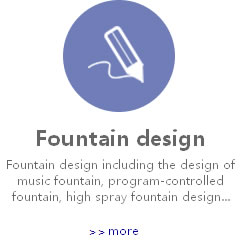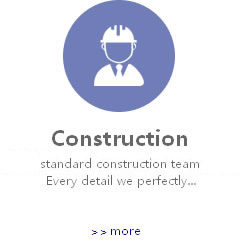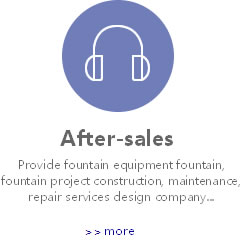Generally speaking, water landscape can be divided into two categories:
One is to use the terrain or civil structure to imitate the natural water landscape. Such as streams, waterfalls, man-made lakes, fishponds, springs, falling water and so on, are widely used in Chinese traditional gardens.
The second is to rely entirely on fountain equipment for landscaping. All kinds of fountains such as music fountains, program controlled fountains, dry land fountains, atomizing fountains, etc. This kind of waterscape is widely used in the field of architecture in recent years, but its development speed is very fast.
All kinds of waterscape projects are generally composed of the following aspects: civil construction tank body, pipeline valve system, power water pump system, lighting system, etc.
Large water bodies or places with high requirements for water quality perception must also have a water quality treatment system.
A good waterscape design must be the product of the perfect combination of the above professional systems on the basis of excellent artistic effect design. Its design points are as follows:
1. Modeling design and nozzle selection
Fountain Company Fountain Project Music Fountain Waterscape Fountain Landscape Fountain
For the overall design of waterscape, we should first analyze the basic requirements of the environmental atmosphere, then analyze various waterscape forms, classify different combination schemes, draw effect diagrams and select the best from among them.
Waterscape forms include still water, running water, falling water and spraying water, which can also lead to various forms of change, especially with the development of spray nozzle technology. With these materials and professional art design, we can draw a beautiful water landscape.
In addition, different landscape forms are suitable for different application scenarios. For example, music fountains are generally suitable for meeting places such as squares. It is an organic combination of music, water shape and light to give people visual and auditory beauty. At the same time, the fountain and the square are merged into a whole, forming part of the building. However, residential buildings are more suitable for designing streams to surround each other so as to reflect a quiet and carefree atmosphere and give people a gentle and relaxed visual enjoyment, thus creating a pleasant living and rest space.
The choice of nozzles is very important in fountain design. Various types of sprinklers are widely used in waterscape to generate different water shapes. At present, there are great differences in the quality of nozzles produced in China. Compared with similar products abroad, the biggest problem is not only the appearance but also the design quality. For example, the parameters provided by a certain manufacturer are far from the actual operation value. The most important requirement of water landscape engineering is beautiful water shape and smooth and stable jet. However, the jet of most domestic products either diverges strongly or shaves horizontally. Even if it is the same batch of products, its water quality is also extremely unstable. Except for the reason that domestic sprinklers lack machining accuracy due to small-scale production, the fundamental problem is that there is no perfect design theory and basis in the design of special sprinklers for water landscape. Therefore, we suggest that the national professional society organize relevant experts to work out practical design specifications and standards as soon as possible, so as to make the waterscape fountain industry in China more standardized and further developed.
In actual use, attention should be paid to the characteristics of various nozzles. The general water film spray head has poor wind resistance and is not suitable for outdoor windy occasions. However, spray heads such as cedar or Yongquan are sensitive to water level changes, so they should not only pay attention to water level changes, but also have corresponding measures to suppress waves in the pool design. For example, a longer overflow weir or an underwater wave barrier may be provided. However, it is also conducive to the construction of pulsating fountains due to the hydraulic phenomenon of wave resonance. The regular surge of waves makes the water jet jump and change regularly. At present, there are also many high-tech fountain equipment, which can also be used in water landscape. The jets of bright springs and jumping springs are very smooth and stable, and they look like glass rods and can fall into the water receiving holes accurately. The spring jumping can be controlled by computer to generate water jet with variable length. The bouncing ball fountain can eject smooth water polo with controllable size. They are very interesting and memorable. All kinds of high-tech sprinklers used in large music fountains and all kinds of high-tech sprinklers and underwater motion machinery and control components used in underwater music fountains are also types
There are many choices.
2. Design of civil engineering pool body
In general, the depth of common landscape pools is 0.6 ~ 0.8m. The reason for this is to ensure the submerged depth of the water intake and the bottom of the pool is a whole plane, which is also convenient for the installation, construction and maintenance of pipeline equipment in the pool. Only in order to reflect
Water absorption pit or pump pit is only used in the design of shallow butterfly pool with hydrophilic characteristics. The water depth of 0.6 ~ 0.8m is actually unsafe. Similarly, in the design of children's play pool, the commonly used depth is about 0.3 ~ 0.6m. Once children fall into the landscape pool, it will be very dangerous. We think the suitable water depth is 0.2 ~ 0.4m .. Another advantage of this is that when the turbidity of the water is slightly higher, the feeling is still clear. The top surface of the pool wall should be available for visitors to sit down and rest. The height of the top surface of the pool wall from the ground is generally 0.30 ~ 0.45 m, except for artificial lakes, the water surface should be higher than the ground. If the water level is low, it will feel like a deep pool. From the point of view of hydrophilicity, the suitable scale is 0.2m from the water surface to the top of the pool wall





